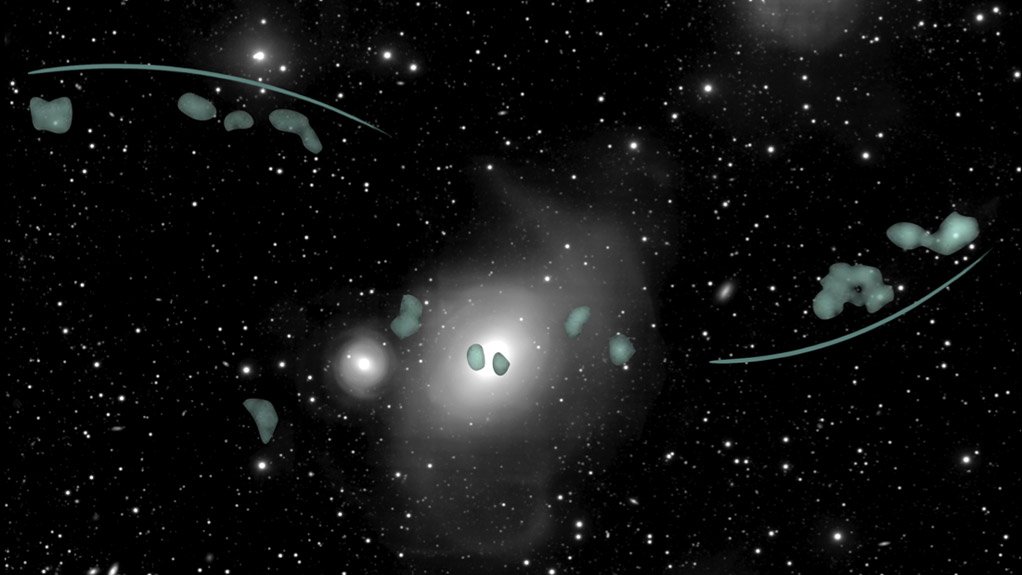South Africa’s MeerKAT radio telescope solves astronomical conundrum


MeerKAT image of NGC 1316/Fornax A (the bright object in the centre of the picture) superimposed on a visual image of the same region from the Italo-Dutch Fornax Deep Survey, showing hydrogen gas concentrations (the green blobs), with the two hydrogen gas tails indicated by the curved lines
Photo by Serra/Sarao
The South African Radio Astronomy Observatory (Sarao), which is one of the National Research Foundation’s facilities, announced on Monday that the country’s MeerKAT radio telescope array had made a major scientific discovery, solving a decades-old astronomical riddle. The discovery, published as a paper in the Astronomy and Astrophysics journal, was made by an international consortium of scientists, including South Africans, which was partly funded by the European Research Council.
The riddle concerned a galaxy designated NGC 1316 (NGC standing for New General Catalogue [of Nebulae and Clusters of Stars]), also known as radio galaxy Fornax A. It lies 60-million light years from Earth and is both the brightest visible-light and the most powerful radio wave-emission galaxy in a cluster of galaxies in the constellation of Fornax. In fact, it is the fourth brightest radio wavelength source in the whole sky.
NGC 1316/Fornax A was created by two major galaxies (the smaller of which would have been about the size of our own galaxy, the Milky Way) colliding, followed by the absorption of smaller satellite galaxies. But observation showed that the galaxy contained far less hydrogen gas than it should (hydrogen being the raw material for the creation and fuelling of stars).
“NGC 1316 contains a very large amount of dust in its interstellar medium,” pointed out Italian National Institute for Astrophysics Cagliari Observatory researcher and project lead author Paolo Serra. It should also have contained an even greater amount of hydrogen. But hitherto, no-one had been able to detect anywhere near that amount of the gas.
“In this article we show new radio images obtained with MeerKAT, which reveal where all the hydrogen was hiding – it’s distributed in two long, faint, gaseous tails, stretching to a large distance from the galaxy,” he explained. “[T]he tails were generated by tidal forces in action during the merger.”
“With this beautiful piece of work, Paolo and his colleagues, among whom are several young South Africans, have significantly advanced our knowledge of the formation and evolution of galaxies,” highlighted Sarao chief scientist Dr Fernando Camilo. “This provides a wonderful taste of what MeerKAT will do in years to come.”
Remarkably, the observations of NGC 1316 were carried out while MeerKAT was still in its commissioning phase. This resulted in only 40 of the array’s 64 dishes being available for the project.
Comments
Press Office
Announcements
What's On
Subscribe to improve your user experience...
Option 1 (equivalent of R125 a month):
Receive a weekly copy of Creamer Media's Engineering News & Mining Weekly magazine
(print copy for those in South Africa and e-magazine for those outside of South Africa)
Receive daily email newsletters
Access to full search results
Access archive of magazine back copies
Access to Projects in Progress
Access to ONE Research Report of your choice in PDF format
Option 2 (equivalent of R375 a month):
All benefits from Option 1
PLUS
Access to Creamer Media's Research Channel Africa for ALL Research Reports, in PDF format, on various industrial and mining sectors
including Electricity; Water; Energy Transition; Hydrogen; Roads, Rail and Ports; Coal; Gold; Platinum; Battery Metals; etc.
Already a subscriber?
Forgotten your password?
Receive weekly copy of Creamer Media's Engineering News & Mining Weekly magazine (print copy for those in South Africa and e-magazine for those outside of South Africa)
➕
Recieve daily email newsletters
➕
Access to full search results
➕
Access archive of magazine back copies
➕
Access to Projects in Progress
➕
Access to ONE Research Report of your choice in PDF format
RESEARCH CHANNEL AFRICA
R4500 (equivalent of R375 a month)
SUBSCRIBEAll benefits from Option 1
➕
Access to Creamer Media's Research Channel Africa for ALL Research Reports on various industrial and mining sectors, in PDF format, including on:
Electricity
➕
Water
➕
Energy Transition
➕
Hydrogen
➕
Roads, Rail and Ports
➕
Coal
➕
Gold
➕
Platinum
➕
Battery Metals
➕
etc.
Receive all benefits from Option 1 or Option 2 delivered to numerous people at your company
➕
Multiple User names and Passwords for simultaneous log-ins
➕
Intranet integration access to all in your organisation


















